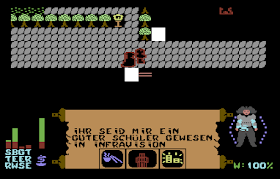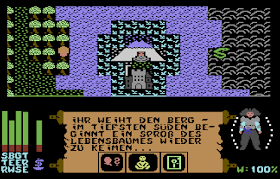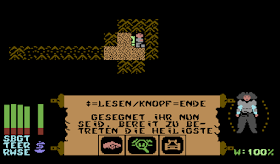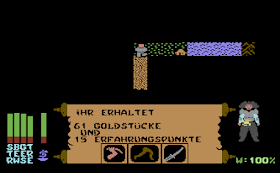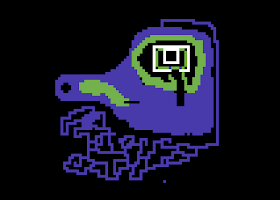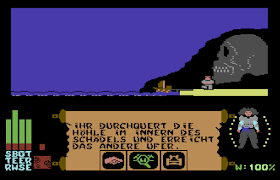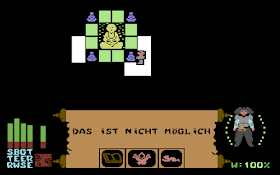 |
| The primary and secondary colors are customizable. This worked for me. |
Ranadinn
United Kingdom
Independently developed; published as shareware by PC-SIG
Released in 1988 for DOS
Date Started: 25 February 2018
Date Ended: 25 March 2018
Total hours: 8
Total hours: 8
Difficulty: Hard (4/5)
Final Rating: 22
Ranking at Time of Posting: 93/290 (32%)
Ranking at Time of Game #402: 147/402 (37%)
If when I started this blog, you had asked me if I had a "perspective preference" when it comes to RPGs, I would have said no. I would have pointed out that there are excellent games in just about all perspectives. Even Neverwinter Nights' (2002) Aurora engine, which tried to have it all ways, has its advantages. My only bias is an irrational disdain for players who play games clearly meant for first-person views in the optional third-person, "over the shoulder" perspective. Judging by YouTube videos, that's a decent majority. I don't want to imagine how such people were raised.
But over the last year or so, as more and more Ultima
clones have aspired to epic status, I've developed a new opinion: if
you use a top-down perspective, you damned well better offer a complete
set of game maps or an in-game automap, or limit your indoor maps to
something small, like 36 tiles squared. Otherwise, I hate you a little.
It's
virtually impossible to map a top-down game. There are too many tiles
to do it on graph paper in a reasonable amount of time, and if you just
try to hand draw it, you end up with a mess. Good games like Ultima IV and Ultima V
understood this. Thus, they provided a "frame" for the large outdoor
areas in the form of the cloth map, which the player could use as a
reference and make his own annotations. For the indoor maps, they kept
to 36 x 36, ensuring that a player couldn't get lost while exploring a
castle or town. It worked fine.
 |
| A small top-down continent doesn't need to be mapped. A large top-down continent can't efficiently be mapped. |
But in the late 1980s, we're seeing a whole slew of games like Deathlord and Nippon
that want to use a top-down perspective but want to use the
improvements in storage media to make their areas enormous, ensuring
that the player either continually misses key areas and NPCs or has to
play for dozens of hours petrified that he has. Nippon thankfully offers in-game maps for each town and makes finding them a kind-of sub-quest. Deathlord and now Ranadinn offer no such considerations.
Ranadinn is an Ultima III/IV-inspired shareware game from Jeff Mather (then) of Tucson, Arizona. We saw his work previously with Silmar (1991). Ranadinn has some innovations but lacks the polish of commercial titles, and it starts with an insane difficulty level, include one game-breaking omission.
The backstory is unoriginal but at least competently told. The character is a polymath--fighter, cleric, and magician--raised and trained by a mysterious ex-king named Osnenemus. ("Ranadinn" is the character's name for his "class," a portmanteau of "ranger" and "paladin." In-game, everyone calls him "battlemage.") Once a mercenary, the character has fallen on hard times because the land is at peace. He thus eagerly accepts a commission to investigate the emergence of a threat to the four islands that make up the kingdom of Aregentan, ruled by King Gregory. It seems that some wizard from the east has gotten hold of the Hand of Mordanneus, an ancient necromancer who channeled his life force and power into his hand before he died. With the hand, the sorcerer is leveling cities and raising an army of monsters. He has put his essence into a black crown and scepter, has broken the crown, and has distributed its pieces to his various lieutenants.
 |
| The king laments. |
There is no character creation--not even a name. Every character starts at Level 3 with 400 experience, 21 hit points, 200 gold, 20 food, 5 torches, and 13 points each in six attributes: strength, intelligence, wisdom, endurance, coordination, and personality. Gems that you find in the dungeons can raise individual attributes. I'm guessing that the row of icons at the top of the screen, which starts with the middle one selected, changes depending on what skills you favor during the course of the game.
You start outside Gregory's castle with no armor or weapons. Commands are limited; aside from the arrow keys to move, you only have (C)hange screen color, (I)gnite torch, (R)anged attack, (U)se possession, and (Q)uit. You talk to NPCs, open doors, and attack with melee weapons by just bashing into those things. ENTER serves as an all purpose "read," "get," and "open" for whatever you happen to be standing on.
Your equipment is limited to swords, bows, and plate mail, the manual's excuse for this being that you weren't taught anything else. Even after you have armor, ranged attacks--which you aim with a targeting cursor--are essential to avoid losing too many hit points too fast.
Spells have to be purchased individually in the form of scrolls. Perhaps later in the game, you have so much gold that the cost becomes trivial, but at the beginning these scrolls are prohibitively expensive even though some of them--"Nullify Traps," "Flame Light," "Cancel Poison," "Unlock"--are effectively necessary.
 |
| Anything else is "unusable." Couldn't I at least take them to sell them? |
Spells have to be purchased individually in the form of scrolls. Perhaps later in the game, you have so much gold that the cost becomes trivial, but at the beginning these scrolls are prohibitively expensive even though some of them--"Nullify Traps," "Flame Light," "Cancel Poison," "Unlock"--are effectively necessary.
 |
| These spells are way out of my reach. |
The indoor areas feature swarms of NPCs, but unlike the Ultima games, they're unnamed and mostly useless, imparting only platitudes instead of authentic hints or bits of lore. "Good day, sir!"; "I wish you well on your journey, sir!"; "I welcome you, Battlemage. May you win your battles for our little kingdom." There are a lot of facilities within the town--e.g., inns, pubs, stables--that are labeled but not functional: there's no way to rent a room or buy a drink or horse.
The game's difficulty becomes apparent quickly. The cheapest armor costs 400 gold pieces, and the only reliable source of gold is inside dungeons, where an armorless character dies within three or four hits of the lowliest enemy. Explore too long in the outdoors, meanwhile, and you eventually run into enemies capable of flinging poison from afar, or undead enemies capable of damaging the character's maximum hit points, rather than just his current hit points.
As for your own hit points, they regenerate at the sluggish pace of 1 every 50 moves. You really need spells to do any serious healing, but again you're almost always under-funded. Poison is essentially a death sentence because scrolls to cure it are enormously expensive and rarely found.
The worst part is that you start the game with only 5 torches, and none of the shops in any town seem to sell torches! (At least, I can't find any. In an e-mail conversation I had with him, Jeff insists they exist, but at least agrees they're not in the towns near the game's beginning.) Once the 5 are gone, your only recourse is to purchase "Flame Light" spells, but you don't find nearly enough gold to keep up with the cost of that spell.
There are a few strengths to the game. First, combat occurs by targeting cursor, which enables ranged attacks and doesn't force the player to artificially target an enemy in his column or row. Ultima V would do the same, but Mather wouldn't have known that when designing this game. Given the preciousness of hit points, ranged attacks become a vital part of combat tactics.
Second, Mather does a good job using the limited icons to set up little scenarios throughout his towns and dungeons. There are clear dining rooms, worship areas, and so forth.
He also copies from Ultima IV the use of minute differences in wall textures to denote secret doors.
I started and restarted the game several times. My best character reached Level 3 (you get a new level with every 200 experience points, but enemies offer only a few per kill), but eventually I played to a standstill. I ran out of torches, cannot afford any more spells, and instant-death foes face me whenever I wander too far in the outer game world.
I could hex-edit myself some more torches, but I wanted to get the developer's perspective, so I wrote to Jeff at his workplace, a company that makes custom software applications. He was aghast that I was trying to play Ranadinn 30 years later and apologized for what he felt were numerous bugs, but I motivated him to download DOSBox and re-investigate it himself. After a few days, he wrote back that he's working on a rewrite, hoping to fix bugs and playability issues. "Who knows when I'll finish," he says, "but the end product (if I do finish) will certainly be superior."
If he'd demonstrated the surprising enthusiasm of Rüdiger and Thorsten (cf. Nippon), I might have stuck with it. As it is, especially given Jeff's own comments, I think I'll let it go . . . for a few games. Ranadinn was re-released in 1989 under a slightly different title (only one n at the end) and with a different graphic set. In about 20 games, I'll see how the remake differs and whether it's worth playing to the end.
 |
| That seems logical. |
The game's difficulty becomes apparent quickly. The cheapest armor costs 400 gold pieces, and the only reliable source of gold is inside dungeons, where an armorless character dies within three or four hits of the lowliest enemy. Explore too long in the outdoors, meanwhile, and you eventually run into enemies capable of flinging poison from afar, or undead enemies capable of damaging the character's maximum hit points, rather than just his current hit points.
 |
| Wandering through this dungeon without armor is asking for trouble, but I need the loot. |
As for your own hit points, they regenerate at the sluggish pace of 1 every 50 moves. You really need spells to do any serious healing, but again you're almost always under-funded. Poison is essentially a death sentence because scrolls to cure it are enormously expensive and rarely found.
The worst part is that you start the game with only 5 torches, and none of the shops in any town seem to sell torches! (At least, I can't find any. In an e-mail conversation I had with him, Jeff insists they exist, but at least agrees they're not in the towns near the game's beginning.) Once the 5 are gone, your only recourse is to purchase "Flame Light" spells, but you don't find nearly enough gold to keep up with the cost of that spell.
There are a few strengths to the game. First, combat occurs by targeting cursor, which enables ranged attacks and doesn't force the player to artificially target an enemy in his column or row. Ultima V would do the same, but Mather wouldn't have known that when designing this game. Given the preciousness of hit points, ranged attacks become a vital part of combat tactics.
Second, Mather does a good job using the limited icons to set up little scenarios throughout his towns and dungeons. There are clear dining rooms, worship areas, and so forth.
 |
| The denizens of this dungeon clearly worship this statue. |
He also copies from Ultima IV the use of minute differences in wall textures to denote secret doors.
 |
| There's one right next to me. |
I started and restarted the game several times. My best character reached Level 3 (you get a new level with every 200 experience points, but enemies offer only a few per kill), but eventually I played to a standstill. I ran out of torches, cannot afford any more spells, and instant-death foes face me whenever I wander too far in the outer game world.
 |
| My character's destiny. |
I could hex-edit myself some more torches, but I wanted to get the developer's perspective, so I wrote to Jeff at his workplace, a company that makes custom software applications. He was aghast that I was trying to play Ranadinn 30 years later and apologized for what he felt were numerous bugs, but I motivated him to download DOSBox and re-investigate it himself. After a few days, he wrote back that he's working on a rewrite, hoping to fix bugs and playability issues. "Who knows when I'll finish," he says, "but the end product (if I do finish) will certainly be superior."
If he'd demonstrated the surprising enthusiasm of Rüdiger and Thorsten (cf. Nippon), I might have stuck with it. As it is, especially given Jeff's own comments, I think I'll let it go . . . for a few games. Ranadinn was re-released in 1989 under a slightly different title (only one n at the end) and with a different graphic set. In about 20 games, I'll see how the remake differs and whether it's worth playing to the end.





















